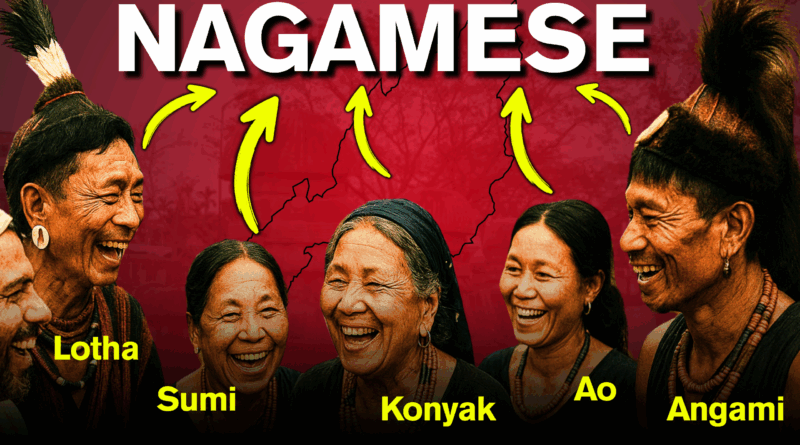Why Nagamese? The Unofficial Language Uniting Nagaland’s Tribes
In a state with over 60 tribal languages, where mutual intelligibility is nearly impossible, how do people speak to each other? The answer in Nagaland is Nagamese—a creole language born out of trade, survival, and history.
Though English is the official language of Nagaland, it is Nagamese that dominates the streets, markets, churches, and even the legislative assembly. Its widespread adoption is not a result of governmental policy, but a remarkable case of linguistic evolution from the ground up.
The Roots: A Language of Trade and Necessity
Nagamese is a creole derived primarily from Assamese, mixed with words from Hindi, English, Bengali, and tribal tongues. Its origins date back centuries when Naga tribes engaged in trade with the plains of Assam. The language developed naturally in the bazaars—what linguists call a “pidgin”—used for barter, negotiation, and daily interaction.
During the British colonial era, as missionaries, traders, and administrators moved through the hills, this trade pidgin spread rapidly. By the early 1900s, Nagamese had become a common bridge between diverse tribes and outsiders. Colonial anthropologists noted how children and adults alike fluently spoke this hybrid tongue, even if they had no schooling.
Why Nagamese Flourished
There are several key reasons why Nagamese became the state’s de facto lingua franca:
- Mutual Unintelligibility Among Tribes: With each tribe—Ao, Angami, Konyak, Lotha, Sumi, Chakhesang, and others—having its own language, inter-tribal communication was impossible without a shared tongue. Nagamese filled that vacuum.
- Ethnic Neutrality: No tribe could claim Nagamese as their own. It wasn’t a “prestige” language, and therefore posed no threat to tribal identities. It was accepted by all and owned by none.
- Simplicity: Nagamese is easy to learn. It has no gendered nouns or complex grammar. This made it ideal for practical communication, especially in informal settings.
- Urbanization and Mixed Living: In urban hubs like Kohima and Dimapur, where people from various tribes co-exist, Nagamese became the language of markets, neighborhoods, and daily social life.
- No Competition: English is used in schools and government. Hindi, though widely understood through media and central officials, was never fully embraced. That left Nagamese as the only effective common speech among ordinary people.
Daily Life, Government, and Church
In Nagaland, Nagamese is the language of the street. It is heard in tea shops, grocery stores, taxis, and festivals. Though rarely written, it is deeply rooted in the oral culture of the people.
Even within the state legislature, MLAs from different tribes often use Nagamese during debates so that everyone can follow. This is perhaps the only example in India where a pidgin-creole is spoken inside a legislative assembly.
In churches, where worshippers from multiple tribes come together, sermons and prayers in Nagamese offer inclusivity. It is also the language of announcements, election campaigns, and sometimes even local news broadcasts.
The Media and Cultural Space
From All India Radio’s Kohima station to YouTube creators and local theater, Nagamese thrives as a spoken medium. In 2013, the state even saw the launch of Nagamese Khobor, a newspaper in Nagamese Roman script. While literacy in Nagamese is not yet institutionalized, its role in oral storytelling and urban pop culture is undeniable.
Musicians mix Nagamese into rap and gospel songs. Youth culture uses Nagamese slang. Social media is slowly shaping its vocabulary and influence, even if the language remains informal and unstandardized.
A Language Both Used and Denied
Despite its omnipresence, Nagamese is not officially recognized. In 2015, a proposal to include it in the Indian Constitution’s Eighth Schedule was met with protests from Naga organizations, who argued that Nagamese lacked a literary tradition and was “not a Naga identity.” Some even called it “broken Assamese.”
This paradox defines Nagamese—it is used by almost everyone but claimed by no one. It unites Nagaland in practice, yet is seen by many as a low-status compromise rather than a cultural asset.
The Future of Nagamese
While English will continue to dominate education and administration, and tribal languages will remain the heart of identity, Nagamese will likely remain the glue that holds Nagaland’s multicultural society together.
As one scholar aptly said, Nagamese has earned its place through “centuries of shared words and understanding.” It may not have the prestige of an official language, but it has something perhaps more enduring: the trust and usage of the people it connects.

